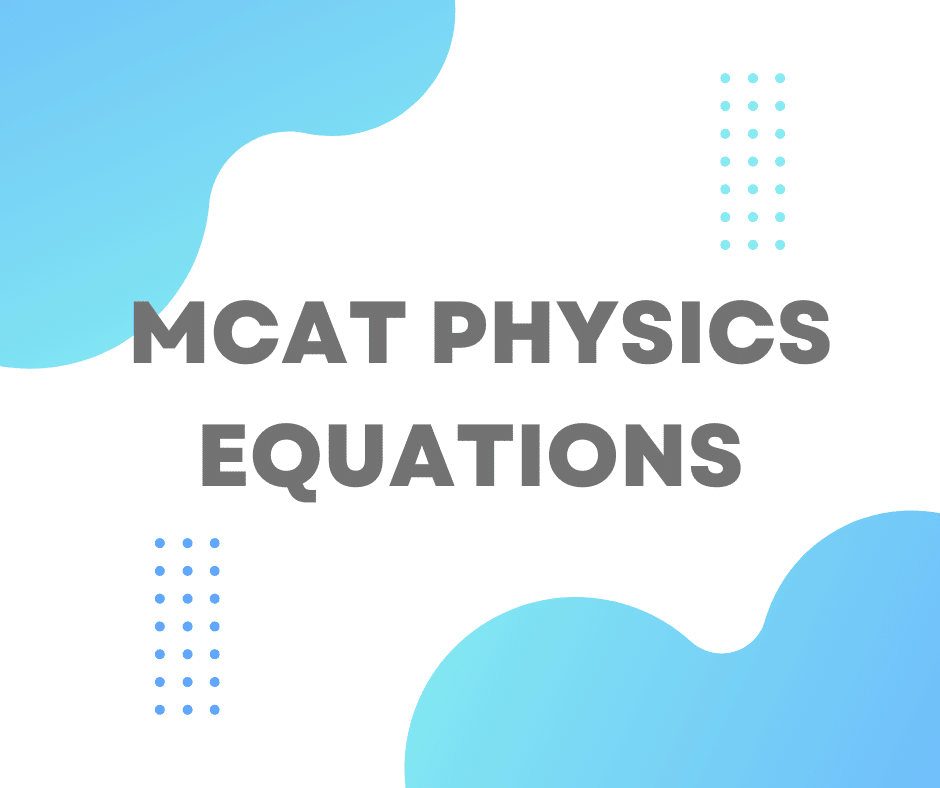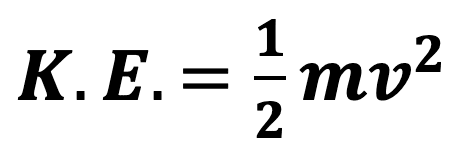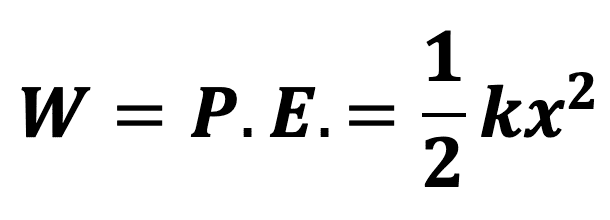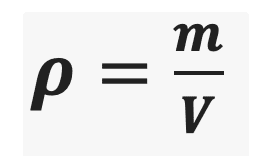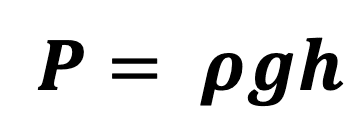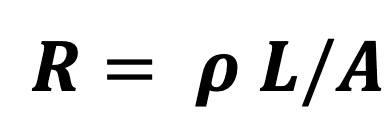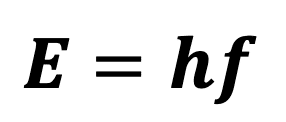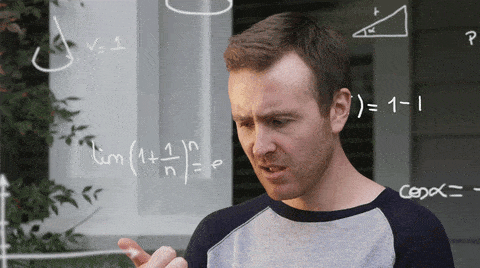MCAT Physics Equations – What are they, and how do they work?
Preparing for the MCAT can feel like navigating a vast ocean of topics, especially when it comes to physics. Physics equations are crucial in the MCAT, bridging theoretical principles and real-world biological systems. They help test your ability to apply physical laws to understand living systems’ functions and behaviors.
One important note: the MCAT does not allow calculators. This means you must develop the skill of solving problems efficiently using mental math and approximations. Success in this area depends on critical reasoning and a strong grasp of core physics concepts.
While college physics might have exposed you to complex, nuanced equations, the MCAT focuses on introductory-level physics. However, don’t let that deceive you—knowing how to use these equations effectively requires practice and conceptual clarity.
How Much Physics is on the MCAT?
The Chemical and Physical Foundations of Biological Systems section tests physics concepts, constituting 25% of the section, according to the American Association of Medical Colleges (AAMC). This portion includes discrete questions and passage-based problems that assess your ability to apply physical principles in a biological context.
Rather than memorizing overly complex equations, the MCAT assesses your ability to:
- Analyze problems critically
- Apply basic physics principles
- Integrate concepts into biological systems
Physics equations for the MCAT revolve around four major categories:
- Basic Physics (Newton’s laws, energy, work)
- Fluids (hydrostatics, Bernoulli’s principle)
- Electricity and Magnetism (Ohm’s law, circuits)
- Waves, Sound, and Light (lens equations, Snell’s law, photon energy)
Types of MCAT Physics Equations
MCAT physics equations can be classified into three main types:
1. Gold-Standard Equations
These are the essential equations that you must memorize. They frequently appear in the test and form the foundation of many problem-solving scenarios.
2. Paired Equations
Some equations work hand-in-hand, such as Ohm’s law (V = IR) and the electric power formula (P = IV). Memorizing these in pairs can streamline your problem-solving process.
3. Application-Based Equations
Certain equations, such as the Doppler effect equation, don’t need to be memorized. Instead, you must understand their principles and how to apply them to a given problem.
This guide provides you with these three types of physics equations and precise background details of these equations.
MCAT Equations
Here is a list of essential physics equations that you need to know to clear the MCAT and get into medical school. We are presenting these equations and formulas under the following content categories:
- Basic Physics
- Fluids
- Electricity and Magnetism
- Waves, Sound, and Light
- Atomic Theory 2
Basic Physics for the MCAT
1. Newton’s Second Law
Newton’s second law of motion, also known as the law of force and acceleration, states that net force applied to an object is directly proportional to its mass ‘m’ and acceleration ‘a’ produced due to that force.
2. Work done by a constant force
Work done by a constant force is equal to the product of the magnitude of the force and the distance covered by the object in the direction of the force.
3. Work-Energy Principle
According to the work-energy principle, the total work done on an object or system equals the change in kinetic energy (K.E.) of that system.4 It is presented as:
4. Kinetic Energy
Kinetic energy is the energy an object possesses due to motion. To move an object, we apply a force ‘F’ and do some work ‘W’ on it. As a result, energy transfers to the object, causing it to start moving. This energy is called “kinetic energy,” and it is given by:
Where ‘m’ is the object’s mass, and ‘v’ is the speed with which it moves.3
5. Gravitational Potential Energy
Potential energy is the form of energy an object possesses because of its position. When an object falls towards the surface of the Earth from the height (h), it experiences gravitational acceleration ‘g’ due to the Earth’s force of gravity. The value of g is 9.8ms-2. The potential energy, in this case, is referred to as ‘gravitational potential energy” and is represented as:
6. Elastic Potential Energy
The potential energy stored in a deformed elastic object. For instance, energy stored in a stretched spring is elastic potential energy. According to Hook’s law, the force required to stretch the spring is directly proportional to the amount of stretch ‘x’, i.e.
Work done to stretch the spring to the distance x equals the potential energy stored in it.
Where ‘k’ is the spring’s constant expressed in N/m. It describes the spring’s stiffness.
7. Law of Conservation of Energy
According to the energy conservation law, energy stored in an isolated system is always conserved. The net energy of a system is equal to the sum of kinetic energy and potential energy.
8. Force of Friction
The force that resists the motion of an object against a surface is known as the force of friction. It is directly proportional to the normal force ‘N’ (contact force).
Here,

is the frictional coefficient.
Fluids
This category involves fluid dynamics concerning pulmonary and circulatory systems.
1. Density
Density is defined as a substance’s mass per unit volume. It measures how tightly the particles are packed together in a medium. The underlying equation presents the density of a material.
Where ‘m’ is the object’s mass and ‘V’ is its volume.
2. Continuity Equation
The continuity equation, i.e., Constant = A.v, describes the conservation of mass in a system. As the system’s mass is conserved, a continuity of flow exists in that system. In this equation, ‘A’ is the cross-sectional area of flow, and ‘v’ is its velocity. The cross-sectional area of a system is inversely proportional to its velocity, and this relationship between the two plays a significant role in maintaining a system’s fluidity.
A1v1=A2v2
Describes fluid flow conservation.
3. Pascal’s Law
Pascal’s law of hydrostatic pressure states that pressure applied to a closed system is uniformly transmitted in all fluid directions regardless of the container’s shape. Hydrostatic pressure is the pressure in a fluid at a given depth, increasing with the fluid’s depth. According to Pascal’s law:
Where ‘P’ is the hydrostatic pressure, ‘p‘ is the density, ‘g‘ is the gravitational acceleration (9.8ms-2), and ‘h’ is the fluid’s depth.
4. Bernoulli’s Equation
Daniel Bernoulli stated that when a fluid flows horizontally, points with higher fluid speed experience less pressure, and points with lower fluid speed experience more pressure. This equation is known as Bernoulli’s principle. Bernoulli’s equation, derived from this principle, explains the relationship between kinetic energy, gravitational potential energy, and fluid pressure. It is presented as follows.

Bernoulli’s equation depicts how we can apply the law of energy conservation to a flowing fluid.
Electricity and Magnetism
1. Coulomb’s Law
Coulomb’s law states that the force of attraction or repulsion between two charged particles is directly proportional to the product of their charges and inversely proportional to the square of the distance between them. The underlying equation represents Coulomb’s law.
In this equation, ‘F’ is the electrostatic force of attraction or repulsion, q1 and q2 are the two charges, and ‘r’ is the distance between them. The proportionality constant ‘k’ is called Coulomb’s constant, and its value is 8.99 x109 N.m2.C-2.
2. Electric Potential
Electric potential is defined as the amount of work required to move a unit charge from one point to another in an electric field. Mathematically, electric potential ‘V’ for a charge ‘q’ that has to move distance ‘r’ is given as:
V = k q/r
Where k is the proportionality constant known as Coulomb’s constant.
3. Electric Current
Electric current ‘I’ is defined as the rate of flow of electrical charge. i.e.
Where ‘q’ is the electric charge, and ‘T’ is the time in which it flows.
4. Ohm’s Law
Ohm’s law describes the relationship between voltage ‘V’ and current ‘I’ flowing between the two points of a conductor. The equation is:
V = IR
Here, R is the proportionality constant called ‘resistance.’ The S.I. unit for resistance is ‘ohm’ and is represented by Ω.
5. Resistance
The material’s property due to which it resists or opposes the flow of current through it is called resistance. Resistance can be calculated by using this formula:
Here:
- R is the resistance,
- 𝜌 (rho) represents the material’s resistivity,
- 𝐿 is the length of the material, and
- 𝐴 is the cross-sectional area of the material.
Resistors are the components of electrical circuits that oppose the current flow to a certain degree.5 The resistors can be connected in series as well as in parallel. Resistance in parallel resistors is calculated as follows:
1/Req. = 1/R1 + 1/R2 + 1/R3…
On the contrary, resistance for resistors connected in series in a circuit is given by:
Req. = R1 + R2 + R3…
6. Capacitance
A capacitor is a “two-terminal electric device” that can store charge. The ability of a capacitor to store charge is called “capacitance.” The capacitance ‘C’ of a capacitor with an electrical charge ‘Q’ and electric potential ‘V’ is given by the equation:
C = Q / V
Capacitors can be connected in series as well as in parallel. The capacitance of capacitors connected in series is calculated as follows:
1/C = 1/C1 + 1/C2…
Similarly, the following mathematical expression calculates capacitance for capacitors connected in parallel.6
C = C1 + C2….
Waves, Sound, and Light
1. Photon Energy
“The amount of energy a single photon carries is known as photon energy.” It is represented as:
Where ‘h’ is the Planck’s constant whose value in System International (S.I.) is
it relates the amount of energy ‘E’ carried by a photon to its frequency ‘f’ and has great significance in quantum physics.
2. Snell’s Law
When a ray of light enters from one medium into another medium, it deviates from its original path. This phenomenon is called refraction. Snell’s law, or the law of refraction, describes the relationship between the refractive indices of the two mediums (n1, n2), angle of incidence (sinθ1), and angle of refraction (sinθ2).
n1 sinθ1 = n2 sinθ2
3. Lens Equation
The lens equation describes how the light rays bend through a lens to form an image. It is presented as:
1/f = 1/i + 1/o
Where ‘o’ is the object’s distance from the lens, ‘i’ is the distance of the image from the lens, and ‘f’ is the lens’s focal length. While using the lens equation, always remember that focal length is negative for a concave lens and positive for a convex lens.
4. Intensity of Sound in decibels
The rate at which a sound wave transfers energy per unit area is defined as its intensity. Although the S.I. unit of acoustic intensity is Watts per square meter, we usually express it in decibels (dB). One bel (B) is equal to ten decibels (dB).

Here, ‘I’ is the sound intensity, and ‘Io’ is the reference sound intensity.
5. Velocity of Sound
The velocity of sound in a given medium can be calculated by using the wave equation, i.e.
In this equation, ‘v’ is the speed of the sound wave, ‘f’ is its frequency, and’ is the wavelength.
Atomic Theory
This section of the MCAT physics syllabus focuses on understanding atomic structure and configuration, subatomic particles, nuclear radiation, atomic behavior, electronic structure, and chemical bonding. While AAMC does not provide specific equations for this category, it’s crucial to have a solid grasp of the following concepts:
- Atomic Structure: Understanding the arrangement of protons, neutrons, and electrons within an atom.
- Subatomic Particles: The properties and behavior of particles like protons, neutrons, electrons, and quarks.
- Nuclear Reactions and Decay: Concepts related to radioactivity, half-life, nuclear fusion, and fission.
- Atomic Radiation: The types of radiation emitted by unstable nuclei (alpha, beta, and gamma radiation).
- Chemical Bonding: How atoms bond to form molecules, including covalent, ionic, and metallic bonds.
Although AAMC doesn’t specify any exact equations for atomic theory, being familiar with these concepts is key to mastering the section.
Applying Equations
Are you unsure about how to apply equations during problem-solving? Feeling overwhelmed by the number of physics equations to memorize for the MCAT? Don’t worry—here are some tips to help you apply equations effectively and efficiently on test day:
1. Be Careful with Units!
One of the most common pitfalls in physics is incorrect unit conversions. Even if you have the right formula and perform the right steps, using the wrong units can lead to the wrong answer.
- Tip: Always keep an eye on the units throughout the problem-solving process. Before jumping into the calculations, check that the units are consistent with your equation.
- Pro Tip: Write down the units to avoid mistakes as you work through the problem. This will help you spot any errors early and save time during the exam.
2. Practice, Practice, Practice!
The best way to familiarize yourself with physics equations and how they work is by solving as many practice problems as possible. The more problems you solve, the better you’ll recognize the type of equation needed and how to apply it to a specific situation.
- Tip: Work through practice problems from various topics, including atomic theory, so you can apply the concepts you’ve learned to different scenarios.
- Pro Tip: Time yourself when practicing to simulate the exam pressure, helping you get comfortable with managing time during the test.
3. Apply Your Physics Concepts
The MCAT physics section isn’t just about memorizing equations; it’s about applying those equations to understand real-world biological systems and responses. This means that you must also understand the underlying physics concepts beyond knowing the formulas.
- Tip: Don’t just memorize formulas—make sure you understand why the equation is used and how it connects to the physical concept it represents.
- Pro Tip: Try to relate abstract physics concepts to biological processes. For instance, understand how atomic behavior and energy levels relate to biochemical reactions or medical imaging technologies.
By focusing on these strategies, you can confidently tackle the MCAT physics section, applying the equations accurately and understanding the core concepts. Practice regularly, stay mindful of units, and prioritize understanding over rote memorization. This approach will set you up for success in the exam!
FAQ MCAT Physics Questions:
What type of physics questions can I expect on the MCAT?
The MCAT physics section covers various topics, including classical mechanics, electromagnetism, thermodynamics, fluid dynamics, atomic theory, and waves/oscillations. You will encounter conceptual and problem-solving questions that require applying equations and physics principles to biological and physical systems.
How can I best prepare for the MCAT physics section?
To prepare effectively:
- Focus on understanding core physics concepts, not just memorizing equations.
- Practice solving problems from each physics topic to improve your problem-solving skills.
- Take MCAT practice tests to understand the format and timing.
- Review key formulas and ensure you understand how to apply them in different contexts.
How important are the equations for MCAT physics?
Equations are essential, but understanding how and when to apply them is even more critical. You don’t need to memorize every equation, but be familiar with the most common ones (like Newton’s laws, energy formulas, and equations for forces and motion) and know how to use them to solve problems. Practice applying them in different scenarios.
How can I apply my knowledge of physics to solve MCAT problems?
The MCAT physics section tests your ability to apply physics concepts to real-world situations. Focus on:
- Understanding the question context: Read the problem carefully to determine which concepts apply.
- Using relevant equations: Select the correct equation based on the problem’s information.
- Thinking critically: Analyze the physical situation and identify key principles, such as conservation of energy or Newton’s laws, that will help you solve the problem.
What’s the best way to learn MCAT physics equations?
The best way to learn equations is by understanding their underlying principles and seeing how they apply in practice. Instead of rote memorization, focus on:
- Understanding the meaning of each variable.
- Relating the equations to real-life scenarios (e.g., how energy conservation works in everyday situations).
- Doing lots of practice problems reinforces how and when to apply the equations.
How do I approach a physics problem I don’t understand on the MCAT?
If you encounter a difficult physics problem:
- Break it down: Identify what information is available and what you need to find.
- Look for relationships: Consider which physical principles apply (e.g., energy conservation, Newton’s laws).
- Work backward: If stuck, try eliminating impossible answers based on the units or logic.
- Move on if necessary: If time is tight, skip the question and return to it later with fresh eyes.
How much time should I allocate for studying physics for the MCAT?
The amount of time you should spend on physics depends on your baseline knowledge. Generally, you should allocate at least 2-3 months for focused MCAT physics preparation. Aim for a balanced study schedule that includes review, practice problems, and full-length practice tests. Prioritize areas where you’re weakest while reinforcing your strengths.
Why is it important to understand MCAT Physics equations?
The “Chemical and Physical Foundations of Biological Systems” section of MCAT analyzes students’ ability to apply physical concepts to understand living systems. Always remember that you need to understand the physics equations apart from cramming them if you want to do well on the MCAT. Understanding the equations is important, as it will help you apply your concepts while solving the problems. Even if you have memorized the equations but still need background knowledge, you cannot apply them to the formulas. So, try understanding these equations and formulas along with the cram jams.
How can I improve my understanding of MCAT physics equations?
How can you memorize a sea of equations and formulas to help you pass the test? For this purpose, you need to consider underlying points.
Know the essential background behind the formula.
Use mnemonics to cram these equations. For instance, Gibb’s free energy formula, i.e.,i.e.
You can memorize it as “Grandma Hates To Swim” and q = mc∆t as “MCAT.”
Write the equations again and again to memorize them.
Solve as many practice questions as possible. It will help you apply memorized equations to the problem questions.
The best thing you can do is to practice as much as possible. Practice does indeed make perfect in this situation.
Good luck with the MCAT!
References
1. Chemical and Physical Foundations of Biological Systems Section: Overview. Students & Residents. Accessed November 8, 2022. https://students-residents.aamc.org/whats-mcat-exam/chemical-and-physical-foundations-biological-systems-section-overview
2. The Chemical and Physical Foundations of Biological Systems What Will the Chemical and Physical Foundations of Biological Systems Section Test? Accessed November 8, 2022. https://students-residents.aamc.org/media/8981/download
3. What is Kinetic Energy? – Definition, Formula, Examples, Unit, Types. BYJUS. https://byjus.com/physics/kinetic-energy/
4. Princeton. Continuity Equation. Princeton.edu. Published 2019. https://www.princeton.edu/~asmits/Bicycle_web/continuity.html
5. Flinn C. Resistance and Resistors. pressbooksbccampusca. Published online 2019. https://pressbooks.bccampus.ca/basicelectricity/chapter/resistance/#:~:text=Resistance%20is%20designated%20with%20R
6. Ling SJ, Sanny J, Moebs W, Janzen D. 4.2 Capacitors in Series and in Parallel. openpressusaskca. Published online November 28, 2018. https://openpress.usask.ca/physics155/chapter/4-2-capacitors-in-series-and-in-parallel/
7. University of British Columbia. Snell’s Law — The Law of Refraction. personal.math.ubc.ca. https://personal.math.ubc.ca/~cass/courses/m309-01a/chu/Fundamentals/snell.htm
